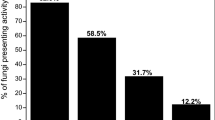Summary
Thirty-nine fungal cultures belonging to the genera of Aspergillus, Podospora, Sordaria, Cbaetomium, Iodophanus, Scleotinia, Coniella, Pellicularia and others, were examined for the production of enzymes which macerate the mandarin orange peel using a wheat bran as substrate. An isolated strain of Aspergillus niger was an excellent producer of macerating enzymes compared to other organisms tested. The peel of the mandarin orange could be macerated by the crude enzymes produced by isolated A. niger. The maceration of 1 g of peel/24 h yielded 0.57 g of reducing sugars. Expressed differently, 83% of solid peel materials were released from the peel into the water/24 h under the following conditions: a peel concentration of 8 g peel/l, a crude enzyme concentration of 1 g protein/l, a temperature of 40°C, a pH of 5, a 24 h incubation time and 120 rpm reciprocal shaking. The test of the macerating activity of commercially available hydrolases on the orange peel showed that the two samples of pectinase originating from A. niger had about the same activity as isolated A. niger whereas the two samples of cellulase originating from Trichoderma viride had remarkably lower activities than A. niger.
Similar content being viewed by others
References
Barker, K.R., Walker, J.C. (1962). Phytopathology 52, 1119–1125
Dubois, M., Gilles, K.A., Hamilton, J.K., Rebers, P.A., Smith, F. (1956). Anal. Chem. 28, 350–356
Endo, A. (1964). Agric. Biol. Chem. 28, 757–764
Ghose, T.K. (1977). Bioconversion of cellulosic substances into energy, chemicals and microbial protein. Aroon Purie at Thomson Press (India)
Hamisa, F.A., Mabrouk, S.S., Abdel-Fattah, A.F. (1977). J. Gen. Appl. Microbiol. 23, 23–27
Koller, A. (1966). Dissertation No. 3774. ETH, Zürich
Lequerica J.L., Lafuente, B. (1977). Rev. Agroquim. Tecnol. Aliment. 17, 71–78
Lowry, O.H., Rosebrough, N.J., Farr, A.L., Randall, R.J. (1951). J. Biol. Chem. 193, 265–275
Mukherjee, S.K., Majumdar, S.K. (1971). J. Ferment. Technol. 49, 759–770
Nelson, N. (1944). J. Biol. Chem. 153, 375–380
Oi, S., Satomura, Y. (1965). Agric. Biol. Chem. 29, 936–942
Shinmyo, A., Davis, I.K., Nomoto, F., Tahara, T., Enatsu, T. (1978). European J. Appl. Microbiol. Biotechnol. 5, 59–68
Author information
Authors and Affiliations
Rights and permissions
About this article
Cite this article
Nishio, N., Nagai, S. Production of macerating enzymes of mandarin orange peel by fungal cultures. European J. Appl. Microbiol. Biotechnol. 6, 371–378 (1979). https://doi.org/10.1007/BF00499167
Received:
Issue Date:
DOI: https://doi.org/10.1007/BF00499167




